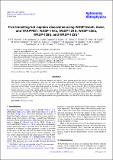Files in this item
Five transiting hot Jupiters discovered using WASP-South, Euler, and TRAPPIST : WASP-119 b, WASP-124 b, WASP-126 b, WASP-129 b, and WASP-133 b
Item metadata
| dc.contributor.author | Maxted, P. F. L. | |
| dc.contributor.author | Anderson, D. R. | |
| dc.contributor.author | Collier Cameron, A. | |
| dc.contributor.author | Delrez, L. | |
| dc.contributor.author | Gillon, M. | |
| dc.contributor.author | Hellier, C. | |
| dc.contributor.author | Jehin, E. | |
| dc.contributor.author | Lendl, M. | |
| dc.contributor.author | Neveu-VanMalle, M. | |
| dc.contributor.author | Pepe, F. | |
| dc.contributor.author | Pollacco, D. | |
| dc.contributor.author | Queloz, D. | |
| dc.contributor.author | Ségransan, D. | |
| dc.contributor.author | Smalley, B. | |
| dc.contributor.author | Smith, A. M. S. | |
| dc.contributor.author | Southworth, J. | |
| dc.contributor.author | Triaud, A. H. M. J. | |
| dc.contributor.author | Udry, S. | |
| dc.contributor.author | Wagg, T. | |
| dc.contributor.author | West, R. G. | |
| dc.date.accessioned | 2016-06-27T09:30:06Z | |
| dc.date.available | 2016-06-27T09:30:06Z | |
| dc.date.issued | 2016-07 | |
| dc.identifier.citation | Maxted , P F L , Anderson , D R , Collier Cameron , A , Delrez , L , Gillon , M , Hellier , C , Jehin , E , Lendl , M , Neveu-VanMalle , M , Pepe , F , Pollacco , D , Queloz , D , Ségransan , D , Smalley , B , Smith , A M S , Southworth , J , Triaud , A H M J , Udry , S , Wagg , T & West , R G 2016 , ' Five transiting hot Jupiters discovered using WASP-South, Euler, and TRAPPIST : WASP-119 b, WASP-124 b, WASP-126 b, WASP-129 b, and WASP-133 b ' , Astronomy & Astrophysics , vol. 591 , A55 , pp. 1-8 . https://doi.org/10.1051/0004-6361/201628250 | en |
| dc.identifier.issn | 0004-6361 | |
| dc.identifier.other | PURE: 243685108 | |
| dc.identifier.other | PURE UUID: 8632a1ba-2453-4a3d-8307-5982036ad60d | |
| dc.identifier.other | Scopus: 84974588688 | |
| dc.identifier.other | ORCID: /0000-0002-8863-7828/work/58531373 | |
| dc.identifier.other | WOS: 000379141300064 | |
| dc.identifier.uri | https://hdl.handle.net/10023/9049 | |
| dc.description | Funding for WASP comes from consortium universities and from the UK’s Science and Technology Facilities Council. TRAPPIST is funded by the Belgian Fund for Scientific Research (Fond National de la Recherche Scientifique, FNRS) under the grant FRFC 2.5.594.09.F, with the participation of the Swiss National Science Fundation (SNF). M. Gillon and E. Jehin are FNRS Research Associates. | en |
| dc.description.abstract | We have used photometry from the WASP-South instrument to identify 5 stars showing planet-like transits in their light curves. The planetary nature of the companions to these stars has been confirmed using photometry from the EulerCam instrument on the Swiss Euler 1.2-m telescope and the TRAPPIST telescope, and spectroscopy obtained with the CORALIE spectrograph. The planets discovered are hot Jupiter systems with orbital periods in the range 2.17 to 5.75 days, masses from 0.3 MJup to 1.2 MJup and with radii from 1 RJup to 1.5 RJup. These planets orbit bright stars (V = 11-13) with spectral types in the range F9 to G4. WASP-126 is the brightest planetary system in this sample and hosts a low-mass planet with a large radius (0.3 MJup,0.95 RJup), making it a good target for transmission spectroscopy. The high density of WASP-129 A suggests that it is a helium-rich star similar to HAT-P-11 A. WASP-133 A has an enhanced surface lithium abundance compared to other old G-type stars, particularly other planet host stars. These planetary systems are good targets for follow-up observations with ground-based and space-based facilities to study their atmospheric and dynamical properties. | |
| dc.format.extent | 8 | |
| dc.language.iso | eng | |
| dc.relation.ispartof | Astronomy & Astrophysics | en |
| dc.rights | © ESO, 2016. This work is made available online in accordance with the publisher’s policies. This is the final published version of the work, which was originally published at: https://dx.doi.org/10.1051/0004-6361/201628250 | en |
| dc.subject | Planetary systems | en |
| dc.subject | QB Astronomy | en |
| dc.subject | QC Physics | en |
| dc.subject | Astronomy and Astrophysics | en |
| dc.subject | Space and Planetary Science | en |
| dc.subject | NDAS | en |
| dc.subject.lcc | QB | en |
| dc.subject.lcc | QC | en |
| dc.title | Five transiting hot Jupiters discovered using WASP-South, Euler, and TRAPPIST : WASP-119 b, WASP-124 b, WASP-126 b, WASP-129 b, and WASP-133 b | en |
| dc.type | Journal article | en |
| dc.description.version | Publisher PDF | en |
| dc.contributor.institution | University of St Andrews. School of Physics and Astronomy | en |
| dc.identifier.doi | https://doi.org/10.1051/0004-6361/201628250 | |
| dc.description.status | Peer reviewed | en |
| dc.identifier.url | http://www.scopus.com/inward/record.url?scp=84974588688&partnerID=8YFLogxK | en |
This item appears in the following Collection(s)
Items in the St Andrews Research Repository are protected by copyright, with all rights reserved, unless otherwise indicated.

